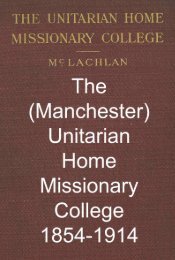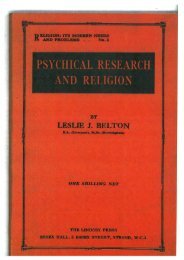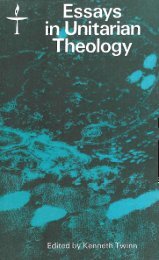Midland Churches: A History of the Congregations on - General ...
Midland Churches: A History of the Congregations on - General ...
Midland Churches: A History of the Congregations on - General ...
You also want an ePaper? Increase the reach of your titles
YUMPU automatically turns print PDFs into web optimized ePapers that Google loves.
him, and cheerfully declared, that he had not <strong>on</strong>e uneasy thought about <str<strong>on</strong>g>the</str<strong>on</strong>g><br />
support <str<strong>on</strong>g>of</str<strong>on</strong>g> his family, though he had <str<strong>on</strong>g>the</str<strong>on</strong>g>n 10 children. The Five Miles'<br />
Act removed him to Deddingt<strong>on</strong>, from whence he used to write letters every<br />
week to his friends at Banbury, some <str<strong>on</strong>g>of</str<strong>on</strong>g> which were afterwards published.<br />
He is known to have besun dissenting worship at Milt<strong>on</strong>. When <str<strong>on</strong>g>the</str<strong>on</strong>g> times<br />
permitted he returned to Banbury and bought a pleasant house, in which<br />
he lived until his death. He and Mr. (afterwards Dr.) White, who was his<br />
successor as <str<strong>on</strong>g>the</str<strong>on</strong>g> parish minister, had a very friendly corresp<strong>on</strong>dence. He<br />
<str<strong>on</strong>g>of</str<strong>on</strong>g>ten heard Mr. White preach, and Mr. White sometimes privately heard<br />
him ; and <str<strong>on</strong>g>of</str<strong>on</strong>g>ten used to say to him, "I pray God bless your labours in<br />
private, and mine in public."<br />
After <str<strong>on</strong>g>the</str<strong>on</strong>g> life and labours <str<strong>on</strong>g>of</str<strong>on</strong>g> such a man as Wells, and <str<strong>on</strong>g>the</str<strong>on</strong>g> Puritan<br />
leanings <str<strong>on</strong>g>of</str<strong>on</strong>g> Banbury and its neighbourhood, it is not to be w<strong>on</strong>dered at,<br />
that before many years had elapsed, a n<strong>on</strong>c<strong>on</strong>forming society is heard <str<strong>on</strong>g>of</str<strong>on</strong>g>,<br />
as existing in Banbury. In 1709 Stephen Davies was ordained its minister,<br />
and in 1716 <str<strong>on</strong>g>the</str<strong>on</strong>g> site <str<strong>on</strong>g>of</str<strong>on</strong>g> <str<strong>on</strong>g>the</str<strong>on</strong>g> present building was bought and prepared for<br />
public worship. Whe<str<strong>on</strong>g>the</str<strong>on</strong>g>r a building was <str<strong>on</strong>g>the</str<strong>on</strong>g>n standing <strong>on</strong> it, which was<br />
c<strong>on</strong>verted to 'I-' uses <str<strong>on</strong>g>of</str<strong>on</strong>g> a meeting-house, or whe<str<strong>on</strong>g>the</str<strong>on</strong>g>r a new place was<br />
erected, does nm seem known for a certainty. What is recorded <str<strong>on</strong>g>of</str<strong>on</strong>g> <str<strong>on</strong>g>the</str<strong>on</strong>g><br />
former house <str<strong>on</strong>g>of</str<strong>on</strong>g> worship is that Joseph Cornish, minister <str<strong>on</strong>g>of</str<strong>on</strong>g> George's meet-<br />
ing, Colyt<strong>on</strong>, 1772-1823, tells us in his autobiography* how he preached<br />
<strong>on</strong> two Lord's days, in 1792, in Mr. Hampt<strong>on</strong>'s spaciolrs place <str<strong>on</strong>g>of</str<strong>on</strong>g> worship ;<br />
in which, for many years during <str<strong>on</strong>g>the</str<strong>on</strong>g> rebuilding <str<strong>on</strong>g>of</str<strong>on</strong>g> <str<strong>on</strong>g>the</str<strong>on</strong>g> Banbury parish<br />
church, <str<strong>on</strong>g>the</str<strong>on</strong>g> ministers and c<strong>on</strong>gregati<strong>on</strong> <str<strong>on</strong>g>of</str<strong>on</strong>g> <str<strong>on</strong>g>the</str<strong>on</strong>g> Established Church were<br />
accommodated ; marriages, and every service being carried <strong>on</strong> <str<strong>on</strong>g>the</str<strong>on</strong>g>re, authorized<br />
by an Act <str<strong>on</strong>g>of</str<strong>on</strong>g> Parliament.+<br />
The hours <str<strong>on</strong>g>of</str<strong>on</strong>g> worship were so ordered that <str<strong>on</strong>g>the</str<strong>on</strong>g> different c<strong>on</strong>gregati<strong>on</strong>s<br />
had both morning and afterno<strong>on</strong> services, and occasi<strong>on</strong>ally an evening<br />
lecture. On <strong>on</strong>e <str<strong>on</strong>g>of</str<strong>on</strong>g> <str<strong>on</strong>g>the</str<strong>on</strong>g> two Sundays alluded to by Cornish, he preached<br />
three times in <str<strong>on</strong>g>the</str<strong>on</strong>g> Old Meeting-house, and besides <str<strong>on</strong>g>the</str<strong>on</strong>g> usual services, <str<strong>on</strong>g>the</str<strong>on</strong>g><br />
-1.Mr. Cobb, writing to me, so recently as August, 1897, says :-It is n curioz~s fact<br />
that my fathy and mo<str<strong>on</strong>g>the</str<strong>on</strong>g>r rucre, in 1795, 71zarrieci in ozrr Old JIeefi?zg-housz, Banbzrry, under<br />
<str<strong>on</strong>g>the</str<strong>on</strong>g> provisi<strong>on</strong>s <str<strong>on</strong>g>of</str<strong>on</strong>g> <str<strong>on</strong>g>the</str<strong>on</strong>g> Act n/Iz~deii to ; aad that 7~234 wife and I were ?lttzwied in <str<strong>on</strong>g>the</str<strong>on</strong>g> same place,<br />
49 years nfmards (IS& by M?-. Abah J<strong>on</strong>zs, <str<strong>on</strong>g>the</str<strong>on</strong>g>n minister at Derby, tcrrder <str<strong>on</strong>g>the</str<strong>on</strong>g> Dissetzters'<br />
Marviage Act ; and Oit7S briftg <str<strong>on</strong>g>the</str<strong>on</strong>g> $rst nmrriape celebmted <str<strong>on</strong>g>the</str<strong>on</strong>g>re, under that Act, 7ut weye<br />
presented with a Bible, recorJinp <str<strong>on</strong>g>the</str<strong>on</strong>g> fact, by nzy wife's fa<str<strong>on</strong>g>the</str<strong>on</strong>g>r, <str<strong>on</strong>g>the</str<strong>on</strong>g> Rcv. Henry Hzrnt Piper, <str<strong>on</strong>g>the</str<strong>on</strong>g>rz<br />
minister. G. E. E.<br />
d<br />
sacrament was administered to <str<strong>on</strong>g>the</str<strong>on</strong>g> members <str<strong>on</strong>g>of</str<strong>on</strong>g> <str<strong>on</strong>g>the</str<strong>on</strong>g> Establishment. By<br />
1850 this building-<br />
had become so dilapidated as to render its removal requisite. A piece <str<strong>on</strong>g>of</str<strong>on</strong>g><br />
ground at <str<strong>on</strong>g>the</str<strong>on</strong>g> back <str<strong>on</strong>g>of</str<strong>on</strong>g> <str<strong>on</strong>g>the</str<strong>on</strong>g> old building was <str<strong>on</strong>g>the</str<strong>on</strong>g> property <str<strong>on</strong>g>of</str<strong>on</strong>g> <str<strong>on</strong>g>the</str<strong>on</strong>g> c<strong>on</strong>grega-<br />
ti<strong>on</strong>, and up<strong>on</strong> that spot <str<strong>on</strong>g>the</str<strong>on</strong>g> new chapel is erected, so that <str<strong>on</strong>g>the</str<strong>on</strong>g> use <str<strong>on</strong>g>of</str<strong>on</strong>g> <str<strong>on</strong>g>the</str<strong>on</strong>g><br />
old building was retained until <str<strong>on</strong>g>the</str<strong>on</strong>g> new <strong>on</strong>e was nearly ready for occupati<strong>on</strong>."<br />
The new place, known as Christ-Church, was opened, under that desig-<br />
nati<strong>on</strong>, <strong>on</strong> Friday, 16 August, 1850. Thanks to <str<strong>on</strong>g>the</str<strong>on</strong>g> ground at <str<strong>on</strong>g>the</str<strong>on</strong>g> disposal<br />
<str<strong>on</strong>g>of</str<strong>on</strong>g> <str<strong>on</strong>g>the</str<strong>on</strong>g> society it stands some 80 yards back from <str<strong>on</strong>g>the</str<strong>on</strong>g> street-<str<strong>on</strong>g>the</str<strong>on</strong>g> Horse-<br />
fair-and is approached by a carriage drive, through a well-wooded enclosure.<br />
The architect was Mr. H. J. Underwood, <str<strong>on</strong>g>of</str<strong>on</strong>g> Oxford, who succeeded in<br />
designing a structure, in early English style, and <str<strong>on</strong>g>of</str<strong>on</strong>g> singularly graceful<br />
proporti<strong>on</strong>s. It c<strong>on</strong>sists <str<strong>on</strong>g>of</str<strong>on</strong>g> nave and chancel, a south aisle, and vestry.<br />
In <str<strong>on</strong>g>the</str<strong>on</strong>g> chancel, under <str<strong>on</strong>g>the</str<strong>on</strong>g> window <str<strong>on</strong>g>of</str<strong>on</strong>g> three lights, <str<strong>on</strong>g>the</str<strong>on</strong>g> centre <strong>on</strong>e <str<strong>on</strong>g>of</str<strong>on</strong>g> which<br />
c<strong>on</strong>tains a ruby-coloured cross, is a reredos <str<strong>on</strong>g>of</str<strong>on</strong>g> seven arches, with st<strong>on</strong>e<br />
mouldings and columns <str<strong>on</strong>g>of</str<strong>on</strong>g> a very graceful character. On <str<strong>on</strong>g>the</str<strong>on</strong>g> north wall<br />
<str<strong>on</strong>g>of</str<strong>on</strong>g> <str<strong>on</strong>g>the</str<strong>on</strong>g> chancel is placed <str<strong>on</strong>g>the</str<strong>on</strong>g> tablet to <str<strong>on</strong>g>the</str<strong>on</strong>g> memory <str<strong>on</strong>g>of</str<strong>on</strong>g> <str<strong>on</strong>g>the</str<strong>on</strong>g> Rev. George<br />
Hampt<strong>on</strong>, M.A., removed from <str<strong>on</strong>g>the</str<strong>on</strong>g> Old Meeting-house. The summit <str<strong>on</strong>g>of</str<strong>on</strong>g><br />
<str<strong>on</strong>g>the</str<strong>on</strong>g> gable over <str<strong>on</strong>g>the</str<strong>on</strong>g> main entrance is surmounted with a st<strong>on</strong>e cross. An<br />
engraving <str<strong>on</strong>g>of</str<strong>on</strong>g> <str<strong>on</strong>g>the</str<strong>on</strong>g> new building was given with <str<strong>on</strong>g>the</str<strong>on</strong>g> Christian LPefarmer, Sep-<br />
tember, 1850. The serm<strong>on</strong>, at <str<strong>on</strong>g>the</str<strong>on</strong>g> opening service, was preached by Charles<br />
Wicksteed, B.A., from Psalm cxxii., I.-" I was glad when <str<strong>on</strong>g>the</str<strong>on</strong>g>y said unto<br />
me, Let us gojnto <str<strong>on</strong>g>the</str<strong>on</strong>g> house <str<strong>on</strong>g>of</str<strong>on</strong>g> <str<strong>on</strong>g>the</str<strong>on</strong>g> Lord." The dedicati<strong>on</strong> prayer was<br />
<str<strong>on</strong>g>of</str<strong>on</strong>g>fered by Mr. Piper, and <str<strong>on</strong>g>the</str<strong>on</strong>g> less<strong>on</strong>s read by Edward Taggart, F.S.A.,<br />
minister, 1828-1858, at Little Portland Street, L<strong>on</strong>d<strong>on</strong>.?<br />
*Of <str<strong>on</strong>g>the</str<strong>on</strong>g> ministers who preached occasi<strong>on</strong>ally in <str<strong>on</strong>g>the</str<strong>on</strong>g> Old Meeting-house, Mr. Cobb<br />
writes (1898) that he believes <strong>on</strong>+ two now sumive, <str<strong>on</strong>g>the</str<strong>on</strong>g> h. Th<strong>on</strong>zas Lethbl-idge Afarshall,<br />
living in ?*eti7*er?zntt i7z Sidttzozrth, who, zclhelz 71zi~zister at Warzoic/L., rrsui to exchn7z,ne ju@its with<br />
Afi*. P$er ; nud j ozrr fa<str<strong>on</strong>g>the</str<strong>on</strong>g>r, <str<strong>on</strong>g>the</str<strong>on</strong>g> Rm. Dnvid Le7uis Ezlnns, at. 86, now living in 9-eti?*ement<br />
at Llanyby<str<strong>on</strong>g>the</str<strong>on</strong>g>)*, S. Lt.'., who, zuhrst nrilrister (1840-1o9qz) <str<strong>on</strong>g>of</str<strong>on</strong>g> <str<strong>on</strong>g>the</str<strong>on</strong>g> B oxhnnz and Ma<strong>on</strong> Chapels,<br />
used to exchafye with <str<strong>on</strong>g>the</str<strong>on</strong>g> Rev. C. B. Nzrbbard, <str<strong>on</strong>g>the</str<strong>on</strong>g>?z nzinister at Banbz~ry. G.E.E.<br />
+At <str<strong>on</strong>g>the</str<strong>on</strong>g> evening meeting Mr. Taggart, alluding to <str<strong>on</strong>g>the</str<strong>on</strong>g> building as " chaste, simple,<br />
and perfect in all its parts and arrangements," said he remembered an anecdote <str<strong>on</strong>g>of</str<strong>on</strong>g> a<br />
royal pers<strong>on</strong>age in c<strong>on</strong>necti<strong>on</strong> with <str<strong>on</strong>g>the</str<strong>on</strong>g> chapel at Bright<strong>on</strong>, which was near <str<strong>on</strong>g>the</str<strong>on</strong>g> Pavili<strong>on</strong>,<br />
and was remarkable for a very beautiful Grecian portico. The m<strong>on</strong>arch <strong>on</strong>e day asked<br />
for what use <str<strong>on</strong>g>the</str<strong>on</strong>g> edifice was designed. He was told that it was a Unitarian Chapel.<br />
And his reply was :-"Ah ! simple and elegant, like <str<strong>on</strong>g>the</str<strong>on</strong>g>ir religi<strong>on</strong>." It was not <str<strong>on</strong>g>of</str<strong>on</strong>g>ten<br />
<str<strong>on</strong>g>the</str<strong>on</strong>g>y were complimented by pers<strong>on</strong>s occupying a royal and kingly stati<strong>on</strong>.<br />
P. 538.<br />
Inq., 1850,






